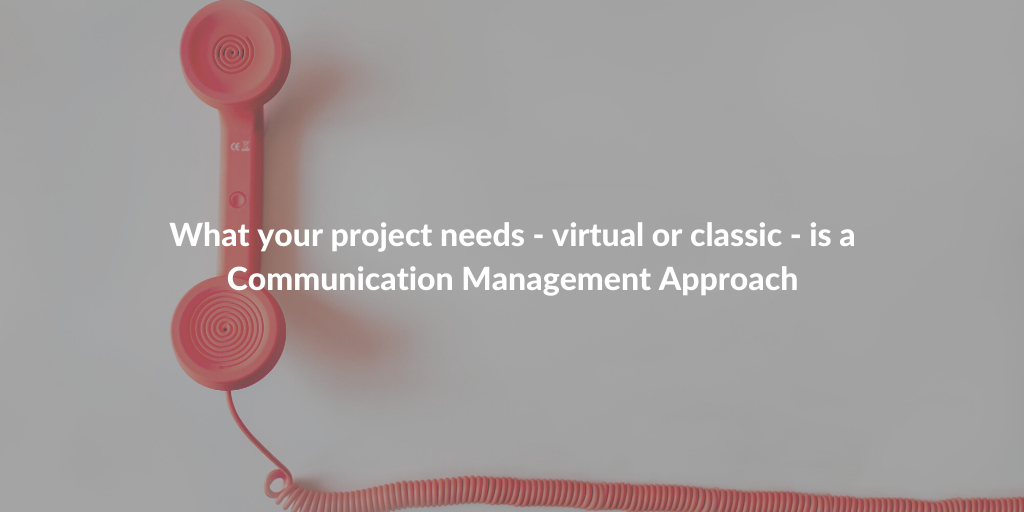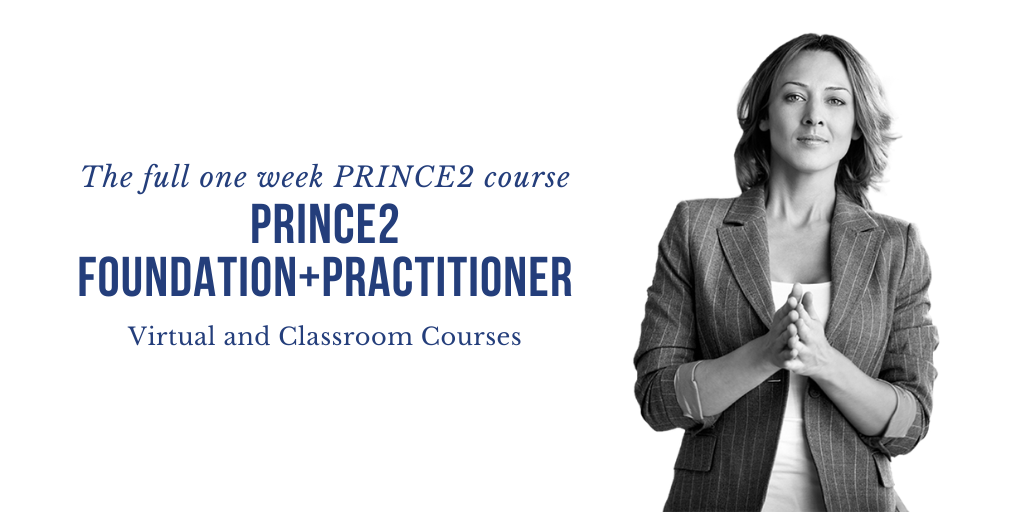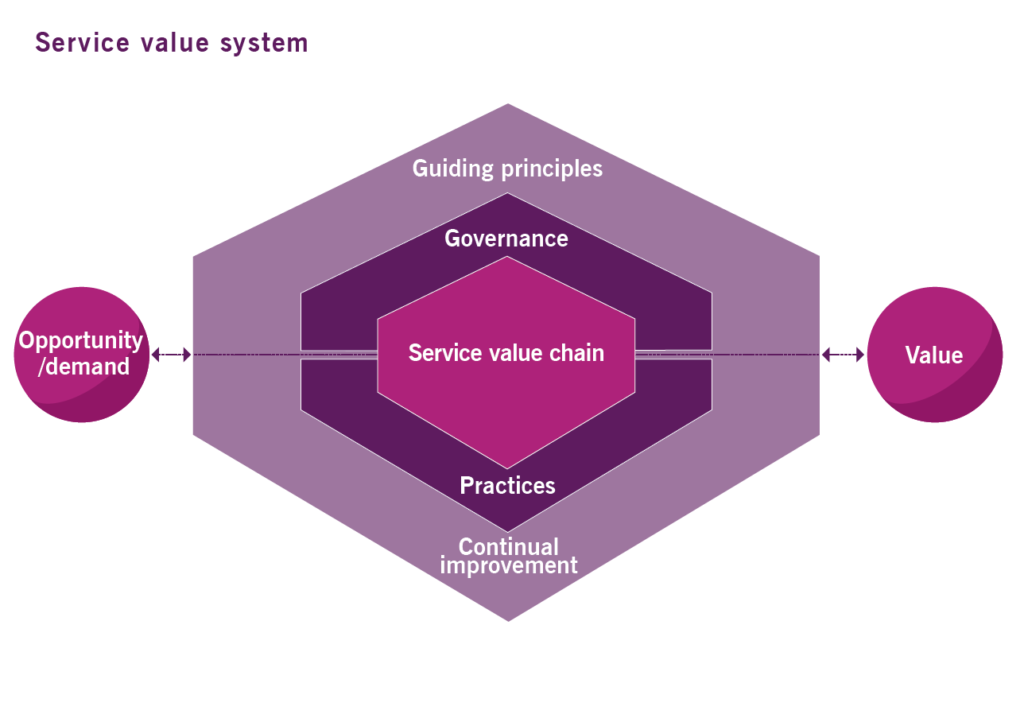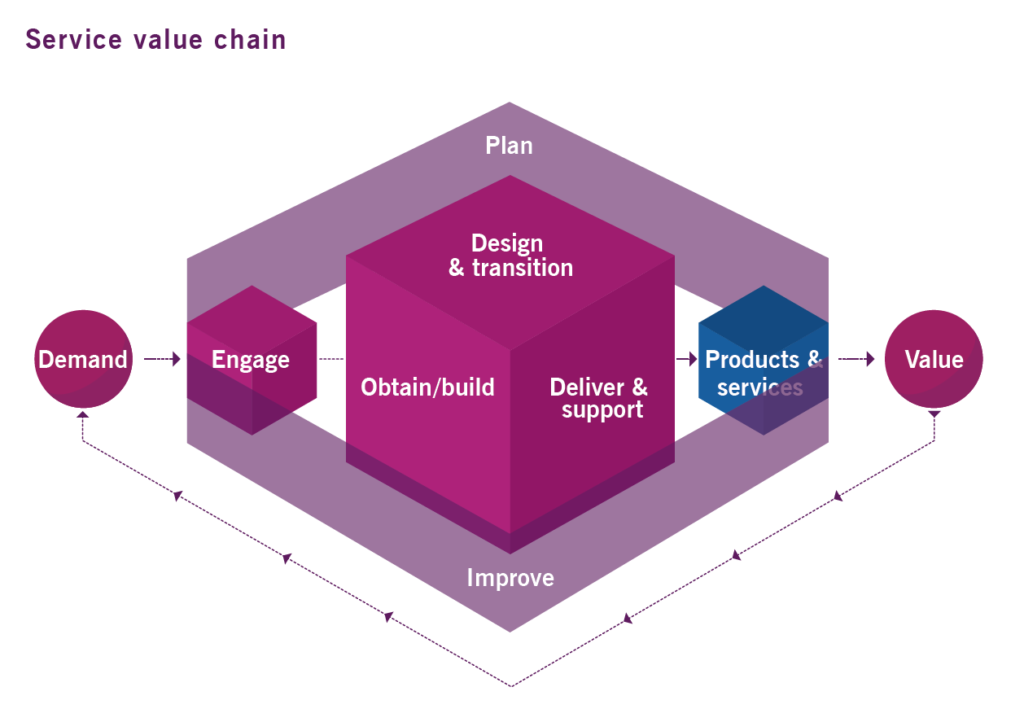News
View the latest inspiring and positive news and information about what's going on in the PM and IT world.

Date: 29/04/2020
In a virtual project, your team works from different locations.
We have seen project teams becoming more virtual for many years - flexible work conditions, external vendors or partners, outsourced teams - and communication is the most important hurdle that keeps popping up. Effectively communicating within your project team is more cumbersome when your project team is not co-located.
A lot of the difficulties lie in the soft aspects of communication: you often lack the visual cues on how a spoken message is received. In written communication, the sender has the tendency to be more negative in communicating the message and the receiver has the tendency to interpret the message more negatively than intended.
The hardest part in remote communication is to create that feedback loop that ensures a message is received as it was intended. When it comes to the mechanics of communication, however, your approach in a virtual environment should actually be quite similar to a situation where everybody is working from the same place.
The problem is that many inefficiencies do not surface as much when you are working in the same building, as you often run into each other or can quickly swing by someone’s desk.
But as usual: time spent in preparation is time gained in execution.
What your project needs - virtual or classic - is a Communication Management Approach.

 Written by: Stijn Janssens is a trainer and consultant.
He is PMP, PRINCE2, MSP, MoP, P3O and ITIL certified.
He has a lot of experience in strategic innovation and the ‘change’ part of organizations.
He is not religious about PRINCE2, but very convinced!
Written by: Stijn Janssens is a trainer and consultant.
He is PMP, PRINCE2, MSP, MoP, P3O and ITIL certified.
He has a lot of experience in strategic innovation and the ‘change’ part of organizations.
He is not religious about PRINCE2, but very convinced!
Read more
PRINCE2 the Communication Management Approach
As in many project management challenges, PRINCE2 gives guidance on how to tackle communication challenges. PRINCE2 is the de facto standard project management method in many parts of the world. And on the topic of communication, it provides guidance in the form of the Communication Management Approach, as well as on how to use it throughout the project life-cycle. PRINCE2 is often considered document-heavy or bureaucratic, but that is a misinterpretation. I rather use PRINCE2 as a checklist of things I need to clarify and agree upon with my project stakeholders. My favourite quote from the PRINCE2 manual (p. 27) states that “it is important to remember that effective project management requires information (not necessarily documents) and decisions (not necessarily meetings).” The situation will determine how well documented this information should be, and whether decisions should be taken in a meeting or not. So let’s have a look at the Communication Management Approach PRINCE2 proposes and how it helps in managing virtual projects. Strictly speaking, the Communication Management Approach deals with the means and frequency of communication with parties both internal and external to the project. I will not go into detail on the external stakeholder identification, analysis, and engagement, but rather focus on internal communication, i.e. with the project team.Tools & Techniques
PRINCE2 is agnostic of tools, so there are no recommendations in the guidance. My advice typically boils down to “do not overthink it”. After all, a fool with a tool is still a fool. So look at the tools that your organisation already uses first. Don’t rely too heavily on email; email is a bad medium in general, but a bad habit is hard to kill. The email has a tendency to lead to communication overload. It is far more useful to use chat tools for written communication, it’s more informal so lowers the effort people spend on the format. That leaves more time for content. Next to a chat, it is also good to have a tool for online meetings, typically videoconferencing, that everyone can easily access from different devices. A screen sharing option is mostly included and very useful. It’s important to have good agreements on how the tools will be used. As a project manager, you should make the guidelines explicit and lead by example. Things to consider are the use of webcams or the mute button for the videoconferences, or the topic structure and use of mentions in the chat. Also, make sure that it is clear which tool will serve what purpose - this is especially important when there are several tools at hand that can do more or less the same.Records
You should keep track of communication records: decisions taken, actions agreed, topics that need to be discussed… Again, email is a bad medium. But you do not necessarily need fancy tools: a lot can be done with a simple document on a shared location that everybody can access. Make sure that everybody knows where they can find what information. Also here it is probably easier and safer to use the technology that your organisation already provides, rather than shopping for new solutions.Timing
Agree when you or others should communicate. That includes the meetings you will have. Online meetings tend to be much more exhausting than offline discussions, and people working from home sometimes have other distractions, like children. So, in a virtual setting even more so than in a classic situation, it is important to keep the number of meetings to the strict minimum! Clear roles and responsibilities and well-defined deliverables will help to reduce the number of synchronous sessions with several people online.Roles & Responsibilities
Make sure to clarify who is responsible for what communication. This means organizing meetings or administering chat groups, but also who should respond to what type of questions. The more you clarify these things upfront, the smoother your project will run.Informal communication
Finally, the above is mainly dealing with formal communications. When I am coaching project managers, I tend to advise them to choose a desk close to the coffee machine. However, it won’t make sense, when working from home, to sit close to your own coffee machine. In an organisation, the coffee machine has the informal function of eliciting real conversations: here you get the real status, the real issues and risks and the real learnings from project team members. So, do not forget these informal moments - try to include them in your routine. That means inviting people for a one-to-one video chat just to have a chat, or organizing a virtual apéro where everyone shares a drink. The drawback of virtual projects is that you need to force some formalization in informal encounters.
Stijn Janssens
 Written by: Stijn Janssens is a trainer and consultant.
He is PMP, PRINCE2, MSP, MoP, P3O and ITIL certified.
He has a lot of experience in strategic innovation and the ‘change’ part of organizations.
He is not religious about PRINCE2, but very convinced!
Written by: Stijn Janssens is a trainer and consultant.
He is PMP, PRINCE2, MSP, MoP, P3O and ITIL certified.
He has a lot of experience in strategic innovation and the ‘change’ part of organizations.
He is not religious about PRINCE2, but very convinced!
Date: 21/04/2020
Managing virtual projects is nothing new.
The world has been becoming flattered for many years and most project managers will have had teams working from different locations. For example companies with different office locations or vendors that were not on customer premises.
The difference in the current COVID-19 situation is mainly that from a few locations where teams were still working physically together, we have been all of a sudden thrown into a setup where everybody is literally on his own.
When confronted with a project management challenge, I typically first look at PRINCE2.
PRINCE2 is one of the most widely used methods for managing projects worldwide. As always, PRINCE2 is only part of the solution. There is a lot of leadership and soft skills involved in managing virtual projects, and PRINCE2 cannot help in that respect.
This is because - although extremely important - it is impossible to codify soft skills and leadership in a method. Managing virtual projects from home also includes a proper work/life balance, however, that is not a subject I like to cover in this post.

 Stijn Janssens is a trainer and consultant. He is PMP, PRINCE2, MSP, MoP, P3O and ITIL certified. He has a lot of experience in strategic innovation and the ‘change’ part of organizations. He is not religious about PRINCE2, but very convinced!
LinkedIn
Stijn Janssens is a trainer and consultant. He is PMP, PRINCE2, MSP, MoP, P3O and ITIL certified. He has a lot of experience in strategic innovation and the ‘change’ part of organizations. He is not religious about PRINCE2, but very convinced!
LinkedIn
Read more
PRINCE2 principles
PRINCE2 approaches project management with 7 principles, 7 themes and 7 processes. The principles are non-negotiable guidelines and practices that apply to every project, no matter its size, type or industry. The seven principles are:
- Continued Business Justification
- Learn from Experience
- Defined Roles and Responsibilities
- Manage by Stages
- Manage by Exception
- Focus on Products
- Tailor to suit the project
Focus on Products
The Focus on Products principle requires projects to be output-oriented rather than work-oriented. For a project, this means that success is driven by having a common understanding of what the project will produce and the characteristics of these products. In everyday speech: the requirements need to be clear, as well as the criteria against which they will be evaluated. The same goes for the work of your project’s teams or individual team members: it is important to agree on what everyone will deliver rather than on what everyone will do. As a project manager, you want to remain in control whilst not micro-managing. That is why it is important to agree with your teams on concrete outputs - deliverables - they will produce by a certain moment. If you manage individual team members directly, it makes sense to have a quick daily check-in. If you deal with teams you probably decrease the frequency to (semi-)weekly. It requires for some a shift in mindset to ask not “what will you do today?” but rather “what will you deliver tomorrow?”. It is a small change, however, it results in both a better alignment of expectations and reassures the project manager that the work contributes to the delivery of the project.Defined Roles and Responsibilities
The Defined Roles and Responsibilities principle means that projects should have an explicit structure that provides everyone involved in the project an answer to the question: What is expected of me? If such a structure is absent you risk that more meetings will be needed to raise hurdles and to determine who will deal with it. In a situation where the team members are co-located, the absence of this explicit understanding of who will do what can be more forgiving as the team members can easier speak up and get help right away. However, this is also suboptimal because everybody in the team will be pulled out of their concentration for a moment and it takes some time to get back to the concentration levels from before. So, make sure that all team members know who is responsible for what, so they can address issues directly with the right person. But also make sure that everyone knows what responsibilities they have themselves so they can make the decisions they are empowered to.Manage by Exception
Manage by Exception principle provides for efficient use of management time as it ensures that decisions are made at the right level in the organisation without losing control. This is done by delegating authority and specifying ‘tolerances’, i.e. performance targets and permissible deviations from those targets. Then you should also specify an escalation mechanism in case the tolerances are (to be) exceeded. If you do this well, reporting progress is a lot easier and does not need a meeting. We all know the feeling of being in a meeting that should have been an email; having clear targets and deviation boundaries allows you to clearly communicate the status of your work or project in short writing. This way, you will only need a meeting when a decision is needed. This means: when someone will exceed tolerance and a higher level of management should step in.Learning from Experience
The Learning from Experience principle requires everyone in the project to actively look for lessons that can be learned from experiences in the project and act upon them to continuously improve. If you are suddenly thrown into this new situation whereby everything happens remotely, it is particularly important to often reflect on how you are handling things. It might be useful to ask all your team members to keep a lessons log, a list of their experiences, and foresee a regular moment to discuss the lessons from the team. By implementing the positive experiences more structurally in your way of working and by resolving negative experiences to avoid these from happening again, you will continuously improve the management of your virtual project.Tailor to Suit the Project
The Tailor to Suit the Project principle ensures that the method used to manage the project is appropriate for the project and that the level of control is appropriate to the project’s scale, complexity, importance, and risk. If your situation suddenly changes, as it has with the whole project team working remotely, it is of utmost importance to check whether your standard way of managing projects is still the most appropriate way of doing so. Every project is unique and hence for every project, you will deviate from the standard in some respects. So take some time to think about how your standard project method should be adapted to your virtual environment.
Stijn Janssens
 Stijn Janssens is a trainer and consultant. He is PMP, PRINCE2, MSP, MoP, P3O and ITIL certified. He has a lot of experience in strategic innovation and the ‘change’ part of organizations. He is not religious about PRINCE2, but very convinced!
LinkedIn
Stijn Janssens is a trainer and consultant. He is PMP, PRINCE2, MSP, MoP, P3O and ITIL certified. He has a lot of experience in strategic innovation and the ‘change’ part of organizations. He is not religious about PRINCE2, but very convinced!
LinkedIn

Date: 23/04/2020
Stijn Janssens is a trainer and consultant. He is PMP, PRINCE2, MSP, MoP, P3O and ITIL certified.
He has a lot of experience in strategic innovation and the ‘change’ part of organizations.

 Stijn Janssens is a trainer and consultant. He is PMP, PRINCE2, MSP, MoP, P3O and ITIL certified. He has a lot of experience in strategic innovation and the ‘change’ part of organizations.
He is not religious about PRINCE2, but very convinced!
Curious about the PMO Usergroup, contact us!
Stijn Janssens is a trainer and consultant. He is PMP, PRINCE2, MSP, MoP, P3O and ITIL certified. He has a lot of experience in strategic innovation and the ‘change’ part of organizations.
He is not religious about PRINCE2, but very convinced!
Curious about the PMO Usergroup, contact us!
Read more
Who are you and what do you do?
I am a consultant and trainer in Best Practices, including PRINCE2, MSP and P3O. I have a lot of real-life experience with the ‘change’ part of organizations, little with Business as Usual. I work as a consultant in different levels of change: from strategic innovation down to delivery. That means that I have set up Project Management Offices, did some Portfolio Management and lots of Project Management. Often I worked in the delivery of these projects, however, I also have experience in the ideation and conceptualization. Being a trainer and a consultant, I believe that quality lies with real-life experience. I could not train others in something that I did not experience myself.How did you arrive in your current position?
I started giving trainings because it basically helps me learn. I find it extremely interesting and rewarding to learn from others and to see how they do their work. With the training I provide, I enter worlds that I did not know that existed. This helps me to become a better trainer and consultant and helps me grow professionally. Being a trainer also pushes me to explain the methodology in a clear way and this helps me understand the methodology better with every course I give. The participants of the course always challenge me with questions and critique and that helps me to constantly improve myself.As a consultant and trainer in Best Practices, where do you see the current problems in the world of Project/Programme/Portfolio Management?
I am convinced that many organizations have great Project Managers that have the correct skill set to perform their role. They know how to write a project plan, follow the plan and keep budgets under control. It all looks great on paper, however, the projects do not deliver. This is often because the organization around the Project Manager is not supportive enough. Strange enough, the answer to solving this problem is simple; PRINCE2. As often believed, PRINCE2 is not just a Project methodology. PRINCE2 is a Project organizational methodology that includes the overall organization. Projects are always unconventional and problems will arise. Often the Project Manager is seen as the one responsible. But if he does not have the correct structure supporting him/her, we cannot blame him/her. Everyone involved in the project has a certain responsibility and PRINCE2 helps to create this awareness and provides structure.Once PRINCE2 is in place, is all solved?
No, PRINCE2 is the start of the answer. PRINCE2 is a tool that will help organizations back on track. However, as every organization is different, there are always some parts missing in PRINCE2. To really get projects to deliver, we need to create some form of co-creation between the ‘change’ part and the ‘business as usual’ of the organization, everybody needs to be included. The organization needs to put a support base in place and everyone should be aware of the project management approach and method the organization has chosen. Training employees for PRINCE2 will help to create this support base. I am convinced that having them get the certification will even help convert the more sceptical ones. But some organizations need more than just training, they need the help of a consultant to help them to change.Can you share a situation where the adoption of PRINCE2 helped solve a problem?
I was invited to give a PRINCE2 course at a production company, I gave the PRINCE2 Foundation course during the Summer and at the end of the year, I gave the PRINCE2 Practitioner course. The overall attitude towards PRINCE2 was very sceptical at first. But when I came back for the Practitioner course, I was astonished by what I saw. They implemented PRINCE2 and tailored it to their needs. They divided the roles, drew the processes and they did an incredible job convincing even the ones on the shop floor to work accordingly. The company was not reaching the international standards, and via a top-down approach, it was urged to follow a PRINCE2 course. The training I provided was very different (and challenging for me), as the questions and situations sketched were all convenient. But once they started applying PRINCE2 the international expectations were met.Your take on PRINCE2 and its future?
PRINCE2 might be old fashioned, but it is still very worth it. I think over the coming years we can see some revisits of the methodology but it will not be too different in essence. I am convinced that it is the most practical and fast solving method for Project Management issues. PRINCE2 has a very simple approach and a strategic view: it does not only focus on the delivery of the project. This is what organizations need now but will also need in the future. It would be great if there would be an active Project Management community like the one that exists for other Best Practices. This would help to create an intercompany support base and would also make intercompany cooperation easier. Plus it would provide a great opportunity to learn from each other.
Your future?
I am not sure what my future will bring. I am currently residing in Hong Kong but I do not know till when. One thing that is for sure is that I love what I do and will keep on doing it, as long as I can keep on learning. I will work as a consultant and trainer and hope to inspire others. I will also actively seek to participate in a PRINCE2/Project Management community. For example, the PMO Usergroup that QRP International organises twice a year. This event is created to talk about all the issues PMO’s encounter and to increase intercompany cooperation. Stijn Janssens is a trainer and consultant. He is PMP, PRINCE2, MSP, MoP, P3O and ITIL certified. He has a lot of experience in strategic innovation and the ‘change’ part of organizations.
He is not religious about PRINCE2, but very convinced!
Curious about the PMO Usergroup, contact us!
Stijn Janssens is a trainer and consultant. He is PMP, PRINCE2, MSP, MoP, P3O and ITIL certified. He has a lot of experience in strategic innovation and the ‘change’ part of organizations.
He is not religious about PRINCE2, but very convinced!
Curious about the PMO Usergroup, contact us!
Date: 15/04/2020
ITIL (Information Technology Infrastructure Library) is a set of specialized organizational capabilities to enable customer value in the form of services. It lays down the foundation for international standard practices that organizations and businesses can adopt, in part or in full, to deliver service value to their customers.
ITIL has been undergoing improvements over the years, with the first publication in the 90s focusing on standardizing IT practices. This was to create standards for IT systems that would make service delivery more efficient. The latest ITIL 4 version is more value-oriented.
ITIL addresses various aspects of IT service management including risk management, service management cost, customer relations, service strategy and more.

Read more
ITIL 4 benefits
ITIL supports organizations and individuals to gain optimal value from IT and digital services. It equips a service provider with a clear capability model, aligning them to the business strategy and customer needs. Change is a constant state and organizations are struggling to navigate it. ITIL 4 is the best practice that supports organizations in navigating this ongoing change. ITIL 4 supports faster quality and value-driven delivery for people and organizations. The main benefits of the method are:- ITIL 4 helps businesses navigate the new technological era; The Fourth Industrial Revolution is marked by emerging technology in fields including robotics, artificial intelligence, nanotechnology, quantum computing, biotechnology, the Internet of Things (IoT), 3D printing, autonomous vehicles and much more.
- ITIL 4 provides a practical and flexible basis to support organizations on their journey into the new world of digital transformation; ITIL helps organizations to align their human, digital and physical resources to compete within the modern complex landscape.
- The context of ITIL 4 has an emphasis on the business and technology world and with the future that includes Agile, DevOps and digital transformation.
- ITIL 4 promotes a holistic view of delivering products and services and is to software developers and gives the insight to service management practitioners and businesses.
- ITIL 4 emphasizes the importance of collaboration, transparency, automating where possible and working holistically.
ITIL 4 components
The key components of the ITIL 4 framework are the ITIL 4 service value system (SVS) and the four dimensions model. ITIL service value system (SVS) The ITIL SVS represents how the various components and activities of the organization work together to facilitate value creation through IT-enabled services. These can be combined in a flexible way, which requires integration and coordination to keep the organization consistent. The ITIL SVS facilitates this integration and coordination and provides a strong, unified, value-focused direction for the organization. The core components of the ITIL SVS are:- ITIL service value chain
- ITIL practices
- ITIL guiding principles
- governance
- continual improvement.
ITIL4: the four dimensions model
To ensure a holistic approach to service management, ITIL 4 outlines four dimensions of service management, from which each component of the SVS should be considered. The four dimensions are:- organizations and people
- information and technology
- partners and suppliers
- value streams and processes.
ITIL 4 Framework
The delegates need the ITIL 4 Foundation qualification to have access to further modules. After the ITIL v4 Foundation certification, there are two streams and a final level available:- ITIL Managing Professional (ITIL MP) consisting of three modules in ITIL Specialist and one in ITIL Strategist. It is aimed at IT professionals who work in cross-company technology and digital teams. The ITIL MP Stream provides practical and technical knowledge for running successful IT projects, teams and workflows.
- ITIL Strategic Leader (ITIL SL) consisting of ITIL Strategist and ITIL Leader. It recognizes the value of ITIL for all digitally enabled services. By becoming an ITIL Strategic Leader you will have a clear understanding of how IT influences and manages business strategy.
- ITIL Master To achieve the ITIL 4 Master certification, professionals must be able to explain and justify their ability to apply the principles, methods and techniques from ITIL in the workplace. Also, candidates must have both the ITIL 4 Managing Professional (ITIL MP) and ITIL 4 Strategic Leader (ITIL SL) designations. The ITIL 4 Master level is due for release in 2020.

ITIL 4 certification training
In order to obtain your ITIL Certification, you need to follow a training with an AXELOS' Accredited Training Organizations (ATOs). QRP International is an official ATO for ITIL 4, accredited by Peoplecert on behalf of Axelos. We’re authorised to deliver ITIL Foundation and other ITIL courses. Would you like support to figure out the best solution for you and your team? We would be happy to provide more info on the different IT Service Management methods available - contact us! Source: Axelos
Date: 08/04/2020
The most recent version of ITIL, ITIL 4 introduced a lot of new concepts. In particular the concepts Service Value System, Service Value Chain and Value Stream. All these are fundamental in ITIL 4.
The Service Value System (SVS) is a model that shows how all components and activities of an organization work together to create value. The Service Value System can help create a unique and strong direction for the organization. It defines the activities, workflows, controls and procedures needed to achieve the agreed objectives.
 On the other hand, the value stream is a series of steps an organization undertakes to create and deliver services and products to consumers. The Value Stream is different for every organization and needs to be specified.
The new version of ITIL provides a generic reference model to be able to create value streams: this model is called Service Value Chain.
On the other hand, the value stream is a series of steps an organization undertakes to create and deliver services and products to consumers. The Value Stream is different for every organization and needs to be specified.
The new version of ITIL provides a generic reference model to be able to create value streams: this model is called Service Value Chain.

Read more
 On the other hand, the value stream is a series of steps an organization undertakes to create and deliver services and products to consumers. The Value Stream is different for every organization and needs to be specified.
The new version of ITIL provides a generic reference model to be able to create value streams: this model is called Service Value Chain.
On the other hand, the value stream is a series of steps an organization undertakes to create and deliver services and products to consumers. The Value Stream is different for every organization and needs to be specified.
The new version of ITIL provides a generic reference model to be able to create value streams: this model is called Service Value Chain.
Service Value Chain
The Service Value Chain is an operating model, which outlines the key activities required to respond to demand and facilitate value realization through the creation and management of products and services. Each organization will allocate the Service Value Chain according to their business needs. The SVC responds to the trigger, the question and the need for an organization. The six main activities of the ITIL Service Value Chain are;- Plan
- Engage
- Design & Transition
- Obtain & Build
- Delivery & Support
- Improve.

Value stream
Different factors are included while creating the value stream, like:- Structure of the organization
- The team
- The competences
- The organizational culture
- The order of activities is not pre-established and can be different every time
- The Value Stream does not concern a single group but involves several teams
- The Value Stream activities do not only involve IT staff but also includes stakeholders
- Each activity of the value stream has specific support and stakeholder practices.
In order to create Value Streams, it is necessary to know the activities, define their priority and manage the possible involvement of external companies.
ITIL provides the Service Value Chain to identify the Value Streams. The organization always starts from the Service Value Chain and uses this model to identify the specific Value Stream. Once an organization has defined its Value Streams, it is easy to follow the activities and practices. It recognizes the stakeholders involved and the activities required to transform the need into something that generates value for everyone. The ITIL4 Managing Professional module of ITIL 4 Create, Deliver & Support provides an understanding of how to integrate value streams. Activities to create, deliver and support IT products and services and related practices, methods and tools. Find out more! QRP International also organized a webinar about the ITIL 4 module Create, Deliver & Support. Our trainer and ITIL 4 expert Kais Albassir explains clearly how this course can be helpful. Watch the recording for free by clicking here. ITIL® is a registered trademark of AXELOS Limited, used under permission of AXELOS Limited. All rights reserved.
Date: 01/04/2020
Davina Leysen works as an Attaché project beheer at Belnet (Programme and Project Officer).
Davina has created a support base for the implementation and use of the P3O structure at Belnet.
Read more
What's your current job title and what does that mean in practice?
My official title in Crescendo: Attaché project beheer at Belnet. When looking at the P3O definitions, my function can be described as a Project and Programme Officer. I support not only our Programme Manager (Head of the Project Management department) but also our Project Managers. In practice, this means keeping our portfolio database up-to-date, organization of the project board, resource management and overall support to all programme and project managers. If needed, I can also perform some Project Management activities.How did you end up in the world of Project, Programme and Portfolio management?
I was originally hired as a member of our purchasing department. As soon as I started working at Belnet, I was detached to work on a big project. My job in that project was to follow up on the delivery of all the orders. This big project was the catalyst to create an official Project Management Office within Belnet. Being able to witness the approach to this major project and the creation of the PMO firsthand, and simply liking the work I was doing, I asked if I could remain on as a permanent member of the new Project Management department.What's the biggest issue/change you see in your network at the moment regarding PM?
Project Management is sometimes (too often) seen as a ‘last resort’. Requests to start up a project often originate from an issue with planning and coordinated action. Due to this, projects have to be started very quickly and there is not always the opportunity to plan and document everything as it should. This then results in unexpected turns and possible delays during the course of the project.What's your advice on how to face the above-mentioned issue?
The PMO has picked up some slack in the past years, with an overall positive outcome. Our work was appreciated as we got things done, which lead to a more positive view of the work we do. Overall, the positive aspects and added value of project management are becoming more and more known within Belnet. For important and large-scale changes, PMO is consulted in early stages, so the benefits of adopting the project approach are high, and acknowledged. We really see a change in the perception of the project management approach. We’ve noticed that, after the creation of the PMO, the other departments thought project management was ‘too much administration’, and that it slowed down the work that needed to be done. This was a perception, coming from just not knowing what we were doing, why we were working the way we did and how this would add value to the outcomes.How did you get everybody involved to create a common approach?
We worked on being transparent and communicating to the whole company. HR gave us the possibility to create our own page on the intranet, that is accessible to everyone. We publish our procedures, approved documentation (Project Briefs, PID’s,…), MOM of the Project Board,… Communication and transparency are key in our day-to-day work, we are always open to receive feedback from our colleagues and take measures to respond adequately to their questions.How do you apply P3O and what does the structure look like?
Every quarter, we organize a Project Information Session, where we announce new and closed projects, any major changes and we present between 2 and 4 projects more in-depth. Our newest communication ‘tool’ we introduced is the Project Information Sheet. This is a 2-page document that explains the project in a way that is comprehensible for everyone – from the Purchase department to the technicians of the Networks department. In the last couple of months, we also have installed a consultation group, where different departments are involved, called the Customer Demand Meeting. During this meeting, different upcoming or recently received customer requests are discussed, and the best approach (Project or Business as Usual) is agreed upon. We can anticipate better what is coming our way, and the transversal collaboration between the teams is strengthening our mandate to execute the projects.What are three things you’ve told yourself that you would like to learn in the near future to develop yourself and your team?
- Change Management As mentioned earlier, we have started our first Programme. This will cause a great change for a large part of the company – almost everybody will have to adapt their way of working in one way or another. I’ve seen some bad and some good examples of change management over the last three years. Well-organized change management has the ability to lift the positive outcomes of a project even higher.
- Improve Excel knowledge Specialized tools for Project/Portfolio Management (used for reporting, budget, timesheets,…) are often very expensive. We try to push the limits of Excel as much as possible, as long as we can. This causes the need for training to write macro’s, create pivot tables and many more.
- Resource Management At the moment, we have a Resource Forecast and Resource Actuals (timesheets) for projects. For operational tasks, there is no company-wide system. At the moment, this remains a manually executed task of copy-pasting individual data into a consolidated file, with quite some room for human error. To minimize these errors, I’ve worked together with our ICT department to automate the consolidation.A next step will be to introduce a resource pool system for the whole company. This should enable us to plan out all the projects in our portfolio. If we know how much time employees will be needed for their operation tasks, we will know the capacity that remains for projects, and we can estimate the duration of each project. On the other hand, if a project has a high priority, we can see where adaptations in the division of the operational work are possible.







